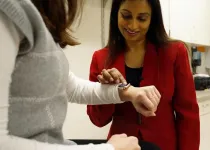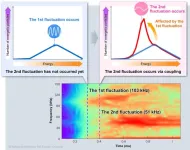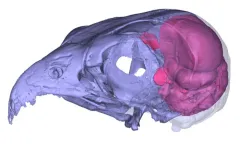(Press-News.org) RELEASE EMBARGOED UNTIL JAN. 22, 12:01 A.M. ET
Note to editor: photos and videos are available for download: https://bit.ly/4jkgIqT
Survey: While most Americans use a device to monitor their heart, few share that data with their doctor
Taking action with your doctor is critical for a proper diagnosis, action plan
COLUMBUS, Ohio – Advances in technology have made it increasingly easier for people to self-monitor their heart health whether it’s via a smart device on their wrist or finger or a blood pressure monitor. However, a new national survey commissioned by The Ohio State University Wexner Medical Center found that while many Americans use a device to monitor their heart, few share that data with their doctor.
The survey of 1,008 Americans found nearly two-thirds use a device on a regular basis to monitor their heart health with the most popular being a smartwatch (32%), portable blood pressure machine (31%), fitness app (19%) and wearable fitness/movement tracker (13%). Of those who use a device, only 1 in 4 use that data to prompt a conversation about their heart health with their doctor.
“These self-monitoring devices are really helpful to patients and their healthcare providers because they can potentially catch things early. For example, if patients are monitoring their blood pressure at home and notice it’s been going up over time, they may want to discuss it with their doctor sooner rather than waiting for their annual visit. Or they may capture some irregular heart rhythms on their devices, like atrial fibrillation, much sooner than would be diagnosed at the doctor’s office,” said Laxmi Mehta, MD, director of Preventative Cardiology and Women’s Cardiovascular Health at the Ohio State Wexner Medical Center and Sarah Ross Soter Endowed Chair for Women’s Cardiovascular Health Research.
Mehta said patients have increasingly been asking her about the pros and cons of self-monitoring health devices. One of those patients is Sue VanWassenhove, 78, of Upper Arlington, whose children got her a smartwatch to track her health after she fell a couple of times. VanWassenhove has sleep apnea, which affects her heart rate and breathing, and she keeps a close eye on what the device is capturing. When her smartwatch showed a pattern of her heart rate dropping, she set up an appointment with Mehta.
“A normal heart rate is between 60 to 100 beats per minute without exercise. Heart rates can vary due to heart conditions or a variety of non-heart related reasons such as infection, dehydration, anxiety or thyroid disorders. When someone’s heart rate or rhythm seems different than usual, it’s best for them to speak with their doctor,” Mehta said.
When it comes to exercise, the maximum heart rate can be calculated by subtracting a person’s age from 220. With moderate intensity exercise, the goal is to hit 50-75% of that number and 70-85% for vigorous exercise, Mehta said. The American Heart Association recommends 150 minutes of moderate intensity aerobic exercise per week or 75 minutes of vigorous exercise per week for maintaining a healthy heart.
During an appointment with Mehta, VanWassenhove learned her smartwatch could do an EKG, which records the electrical signals in the heart, and she could send the results to Mehta through her electronic medical chart.
“Having a smartwatch is very empowering because I’m not being passive with my healthcare. I have some heart issues that need monitored, and it’s important for me to talk to my cardiologist or primary care doctor about any health issues that show up on my watch,” VanWassenhove said.
Survey Methodology
This study was conducted by SSRS on its Opinion Panel Omnibus platform. The SSRS Opinion Panel Omnibus is a national, twice-per-month, probability-based survey. Data collection was conducted from Dec. 16 – Dec. 18, 2024, among a sample of 1,008 respondents. The survey was conducted via web (n=978) and telephone (n=30) and administered in English. The margin of error for total respondents is +/-3.6 percentage points at the 95% confidence level. All SSRS Opinion Panel Omnibus data are weighted to represent the target population of U.S. adults ages 18 or older.
###
END
Survey: While most Americans use a device to monitor their heart, few share that data with their doctor
Taking action with your doctor is critical for a proper diagnosis, action plan
2025-01-22
ELSE PRESS RELEASES FROM THIS DATE:
Dolphins use a 'fat taste' system to get their mother’s milk
2025-01-22
Juvenile dolphins were found to have specialized receptors for fatty acids on their tongues, offering new insights into their growth and feeding habits.
Scientists have discovered that juvenile bottlenose dolphins have specialized receptors for detecting the fatty acids in their mother’s milk. These findings, published in the journal Marine Mammal Science, offer important insights into how these marine mammals grow, feed, and communicate.
The new findings challenge previous assumptions about cetacean sensory systems. Unlike land mammals, dolphins and other marine mammals have limited olfactory capabilities – their sense of smell is largely ...
Clarifying the mechanism of coupled plasma fluctuations using simulations
2025-01-22
Background
In nature, phenomena in which multiple fluctuations occur in a coupled manner are frequently observed. For example, in large earthquakes, cases of them occurring consecutively in adjacent regions have been reported. When multiple fluctuations occur in this coupled way, compared to a single fluctuation, the coupled ones release more energy, leading to larger-scale phenomena. In fusion plasmas, fluctuations caused by energetic particles exist and are known to degrade the confinement of energetic particles. ...
Here’s what’s causing the Great Salt Lake to shrink, according to PSU study
2025-01-22
The Great Salt Lake, the largest saltwater lake in the Western Hemisphere, reached historic low levels in 2022, raising economic, ecological and public health concerns for Utah. New research from Portland State is believed to be the first peer-reviewed study that quantifies the contributing factors to the record low water volume levels, which the researchers say is important for anticipating and managing future lake changes.
“The lake has a lot of social and economic relevance for the region and Utah,” said Siiri Bigalke, the lead author and a Ph.D. candidate in PSU’s Earth, ...
Can DNA-nanoparticle motors get up to speed with motor proteins?
2025-01-22
DNA-nanoparticle motors are exactly as they sound: tiny artificial motors that use the structures of DNA and RNA to propel motion by enzymatic RNA degradation. Essentially, chemical energy is converted into mechanical motion by biasing the Brownian motion. The DNA-nanoparticle motor uses the "burnt-bridge" Brownian ratchet mechanism. In this type of movement, the motor is being propelled by the degradation (or "burning") of the bonds (or "bridges") it crosses along the substrate, essentially biasing its motion forward.
These nano-sized motors are highly programmable and can be ...
Childhood poverty and/or parental mental illness may double teens’ risk of violence and police contact
2025-01-22
Living with persistent poverty and/or parental mental illness throughout childhood may double the risk of carrying and/or using a weapon and getting on the wrong side of the law by the age of 17, suggests research published online in the Journal of Epidemiology & Community Health.
These factors may account for nearly 1 in 3 cases of weapon use or carriage and more than a quarter of all police contact among 17 year olds, nationwide, estimate the researchers.
Youth crime and violence are common around the world, they note. In England and Wales, for example, around 104,400 first-time offenders were ...
Fizzy water might aid weight loss by boosting glucose uptake and metabolism
2025-01-22
Fizzy water might aid weight loss by boosting blood glucose uptake and metabolism—the rate at which the body uses and converts energy—but the effects are so small, drinking it can’t be relied on alone to shed the pounds, concludes a brief analysis published in the open access journal BMJ Nutrition Prevention & Health.
There are no quick fixes to slimming down and keeping off the weight, says the author: regular physical activity and a healthy balanced diet are still essential, added to which the long term effects of drinking large amounts of carbonated water aren’t known.
Because ...
Muscular strength and good physical fitness linked to lower risk of death in people with cancer
2025-01-22
Muscular strength and good physical fitness are linked to a significantly lower risk of death from any cause in people with cancer, finds a pooled data analysis of the available evidence, published online in the British Journal of Sports Medicine.
Tailored exercise to boost muscle strength and cardiorespiratory fitness in patients with cancer may help boost their chances of survival, suggest the researchers.
In 2022 alone, 20 million people were diagnosed with cancer worldwide, and nearly ...
Recommendations for studying the impact of AI on young people's mental health proposed by Oxford researchers
2025-01-22
A new peer-reviewed paper from experts at the Oxford Internet Institute, University of Oxford, highlights the need for a clear framework when it comes to AI research, given the rapid adoption of artificial intelligence by children and adolescents using digital devices to access the internet and social media.
Its recommendations are based on a critical appraisal of current shortcomings in the research on how digital technologies’ impact young people’s mental health, and an in-depth analysis of the challenges underlying those shortcomings.
The paper, “From ...
Trump clusters: How an English lit graduate used AI to make sense of Twitter bios
2025-01-22
An English literature graduate turned data scientist has developed a new method for large language models (LLMs) used by AI chatbots to understand and analyse small chunks of text, such as those on social media profiles, in customer responses online or for understanding online posts responding to disaster events.
In today’s digital world, such use of short text has become central to online communication. However, analysing these snippets is challenging because they often lack shared words or context. This lack of context makes it difficult for AI to find patterns ...
Empty headed? Largest study of its kind proves ‘bird brain’ is a misnomer
2025-01-22
It’s difficult to know what birds ‘think’ when they fly, but scientists in Australia and Canada are getting some remarkable new insights by looking inside birds' heads.
Evolutional biologists at Flinders University in South Australia and neuroscience researchers at the University of Lethbridge in Canada have teamed up to explore a new approach to recreating the brain structure of extinct and living birds by making digital ‘endocasts’ from the area inside a bird skeleton’s empty cranial space.
Published today in Biology Letters, the study led by the ‘Bones and Diversity Lab’ at Flinders and the Iwaniuk Lab at the University ...
LAST 30 PRESS RELEASES:
NTP-enhanced lattice oxygen activation in Ce-Co catalysts for low-temperature soot combustion
Synergistic interface engineering in Cu-Zn-Ce catalysts for efficient CO2 hydrogenation to methanol
COVID-19 leaves a lasting mark on the human brain
Scientists use ultrasound to soften and treat cancer tumors without damaging healthy tissue
Community swimming program for Black youth boosts skills, sense of belonging, study finds
Specific depressive symptoms in midlife linked to increased dementia risk
An ‘illuminating’ design sheds light on cholesterol
Who is more likely to get long COVID?
Study showcases resilience and rapid growth of “living rocks”
Naval Research Lab diver earns Office of Naval Research 2025 Sailor of the Year
New Mayo-led study establishes practical definition for rapidly progressive dementia
Fossil fuel industry’s “climate false solutions” reinforce its power and aggravate environmental injustice
Researchers reveal bias in a widely used measure of algorithm performance
Alcohol causes cancer. A study from IOCB Prague confirms damage to DNA and shows how cells defend against it
Hidden viruses in wastewater treatment may shape public health risks, study finds
Unlock the power of nature: how biomass can transform climate mitigation
Biochar reshapes hidden soil microbes that capture carbon dioxide in farmland
Reducing saturated fat intake shows mortality benefit, but only in high-risk individuals
Manta rays create mobile ecosystems, study finds
Study: Mixed results in using lipoic acid to treat progressive multiple sclerosis
Norbert Holtkamp appointed director of Fermi National Accelerator Laboratory
New agentic AI platform accelerates advanced optics design
Biologists discover neurons use physical signals — not electricity — to stabilize communication
Researchers discover that a hormone can access the brain by hitchhiking
University of Oklahoma researcher awarded funding to pursue AI-powered material design
Exploring how the visual system recovers following injury
Support for parents with infants at pediatric check-ups leads to better reading and math skills in elementary school
Kids’ behavioral health is a growing share of family health costs
Day & night: Cancer disrupts the brain’s natural rhythm
COVID-19 vaccination significantly reduces risk to pregnant women and baby
[Press-News.org] Survey: While most Americans use a device to monitor their heart, few share that data with their doctorTaking action with your doctor is critical for a proper diagnosis, action plan






